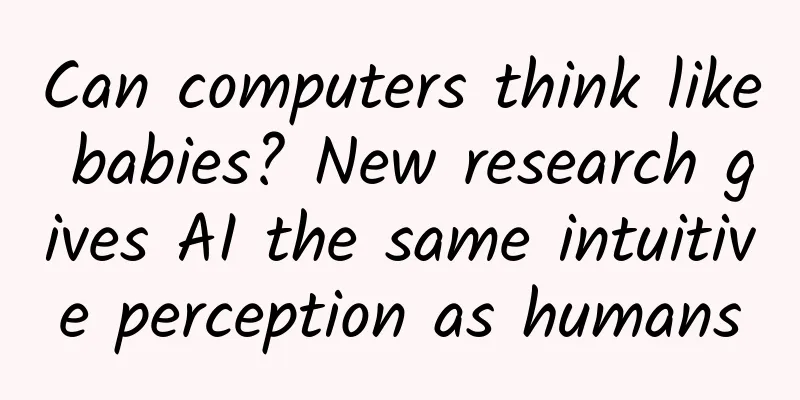Can computers think like babies? New research gives AI the same intuitive perception as humans

|
It is already a cliché that artificial intelligence can play chess and even defeated the world Go champion. Although AI is so powerful, it only uses deep learning and countless training sessions to enable it to calculate the optimal solution from the training database when faced with practical problems. This does not mean that the robot can think independently like humans. On July 11, Deep Mind's latest article on AI made a breakthrough. Researchers used knowledge from the field of developmental psychology to enable AI to "learn to think" like human babies. Previously, the most advanced AI systems still found it difficult to capture "common sense" knowledge in everyday human scenarios, such as guiding predictions, reasoning, and actions. It can be said that this research by Deep Mind has greatly advanced the development of artificial intelligence in terms of intuitive perception. Since then, artificial intelligence has really become more like "human". Written by Xu Shilu Produced by: Science Popularization China-Starry Sky Project Image via Deep Mind As early as the advent of robots, many people have imagined: What would the world be like if robots could think like humans? (I believe the corresponding movie scenes have emerged in your mind) This question has been shelved for many years, but a recent study published in Nature Human Behavior shows that artificial intelligence may have the ability to "think like a baby": it can understand intuitive physics like a baby. It is worth mentioning that this is the result published by researchers from the well-known artificial intelligence company Deep Mind. Luis Piloto, the corresponding author of the paper, previously studied at Princeton University Luis Piloto and his colleagues built a deep learning system called PLATO that can learn intuitive physics. PLATO contains a system inspired by research on how infants learn. And PLATO follows the theory that objects play a central role in representing and predicting the physical world around us. Specifically, the researchers trained PLATO by showing it many videos depicting simple scenes, such as a ball falling to the ground, a ball rolling behind other objects and reappearing, and many balls bouncing back and forth. After training, PLATO showed "surprise" like a human baby when it saw meaningless scenes (such as objects passing through each other without interacting). Amazingly, PLATO achieved the above learning results after watching only 28 hours of video. What is intuitive physics, and how do babies understand it? And how does AI learn it? What is intuitive physics as seen by babies? First, let's clarify a concept. What is intuitive physics? We can simply understand it as "intuition" or "common sense." For example, if we drop a bunch of keys above the table, everyone knows that the keys will not float in the air, nor will they pass through the table and fall to the ground, but will fall on the table. This is "intuitive physics," the fundamental physical concept by which we understand the world and a key component of "common sense" in our thinking. In the field of developmental psychology, intuitive physics is divided into five concepts: 1. Continuity: Objects do not teleport from one place to another, but follow a continuous path in time and space; 2. Object permanence: objects do not disappear when they are no longer visible; 3. Solidity: Objects do not penetrate each other; 4. Immutability: the properties of an object (such as shape) do not change; 5. Directed inertia: The path of an object's motion is consistent with the principle of inertia. Are they all easy to understand? Yes, these are all “common sense” concepts that we can easily understand and accept. If the key's falling process goes against our common sense, such as floating in the air, passing through the table, bouncing up high from the table, or even turning into liquid, then things will be beyond our expectations and become weird. Everyone is surprised by this bizarre event. Even three-month-old babies will express surprise at such a violation of intuitive physics, a surprise response known as the violation of expectations (VoE) effect. As to whether infants' understanding of the world is the same as that of adults, there is a controversy about "nature" and "acquired". Many developmental scientists believe that it is "nature", while some scholars support the "acquired" theory that something is created from nothing. So can we design a program that simulates baby thinking and, through proper training, enable AI to think like a baby? How to train AI to think like a baby? To explore this controversial question of “nature” and “nurture,” Piloto et al. used the PLATO simulation system to test whether deep learning systems could acquire an understanding of intuitive physics by learning from visual animations. If the theory of "nurture" is correct, then the key to intellectual development lies in training through processing large amounts of experience and large amounts of data. The PLATO simulation system consists of two modules: a feedforward perception module (left) and a cyclic dynamic predictor module (right). In the feedforward perception module, the image is converted into a set of object codes through the encoder, and the object code is decoded into the image of the object through the decoder module. The difference between the reconstructed and original images is used to train the parameters of the encoder and decoder. In the cyclic dynamic module, the dynamic module predicts the state of the object at the next moment through a pre-trained decoder. The study used surprisingly little training data to give AI a stable expectation violation effect. When faced with situations beyond 5 intuitive physical concepts, the PLATO simulation system shows a robust (i.e., stable) VoE effect. This can explain some intuitive physics concepts, but this effect is not completely consistent with what is seen in infants. The study found that while experience with visual animation makes an important contribution to intellectual development, it is not sufficient to explain the phenomena we see in infants. That is to say, the development of intelligence does not rely entirely on "acquired" experience and data. To form a complete intelligence, some innate cognition is also required. This study has established an interesting middle ground between the "nature" and "acquired" schools. When the videos became physically impossible, the AI's expressions of surprise increased significantly. In addition, the PLATO simulation was able to generalize expectations consistent with intuitive physics to a set of objects and events that were different from those used in training. Second, despite relatively little training with visual animations, the simulation was able to successfully demonstrate learning, a feature similar to that seen in studies with infants. It can be seen that by integrating the work of simulation modeling with key issues in developmental psychology, the researchers obtained unexpected results and conclusions. Currently, the research team is expanding the study of the expectation violation effect to the field of neurophysiology, which may open up new possibilities for subsequent research and provide more possibilities for the development of AI. References 1. Can a computer think like a baby? Nature News. 2. Intuitive physics learning in a deep-learning model inspired by developmental psychology. https://doi.org/10.1038/s41562-022-01394-8. Special Tips 1. Go to the "Featured Column" at the bottom of the menu of the "Fanpu" WeChat public account to read a series of popular science articles on different topics. 2. Fanpu provides a function to search articles by month. Follow the official account and reply with the four-digit year + month, such as "1903", to get the article index for March 2019, and so on. Copyright statement: Personal forwarding is welcome. Any form of media or organization is not allowed to reprint or excerpt without authorization. For reprint authorization, please contact the backstage of the "Fanpu" WeChat public account. |
Recommend
Where will the next main battlefield be for video websites under attack from both inside and outside?
From corporate mergers and acquisitions, copyrigh...
Why is the omni-channel model the inevitable choice for mobile communications retail in the 5G era?
On November 18, 1987, Guangzhou Mobile Phone Bure...
2020 Zhihu traffic secrets, the most comprehensive explanation on the entire network
I wonder what promotion and traffic generation me...
A new way to place wedding photography video ads!
This article shares with you a case study of the ...
World Economic Forum: Global hydrogen energy competition intensifies, EU increases policy support for renewable hydrogen
China, the United States and Japan have all intro...
User Operations: How do your users make choices?
How people will choose is a very complicated ques...
The key words in my design: matching
In the mobile era, users' aesthetic requireme...
Brand promotion: Where is the entry point for offline interactive advertising?
1. The advertising industry’s thoughts and concer...
11 ways to attract private domain traffic on Douyin
Although Douyin is relatively more focused on pub...
A must-read for women! How terrible is “corpus luteum rupture”?
The following incident happened at the Asian Game...
Lenovo launches 7-inch tablet S5000 to compete with Asus Nexus 7
[September 9 news] After ASUS launched the Nexus 7...
Do picked durian and fallen durian taste different?
More than a hundred years ago, the famous British...
Taobao customer promotion, traffic diversion and fission techniques!
As we all know, there are flash sale groups and c...
In 2016, these six industries will be completely reshuffled
In 2015, everyone started their own business, and...
Zero-based flat texture style commercial illustration tutorial
Zero-based flat texture style commercial illustra...









